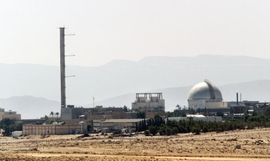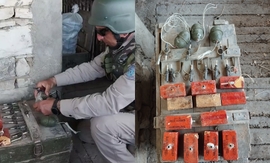More than 3,000 people in Azerbaijan have lost their lives as a result of mine blasts in Azerbaijani territories that were once occupied by Armenia and carpeted with landmines by Armenian forces.
The figure was revealed by Deputy Foreign Minister of Azerbaijan, Elnur Mammadov, at a human rights conference in Azerbaijan’s capital Baku on Wednesday. According to him, a total of 3,300 Azerbaijanis have been killed by Armenian mines since the First Karabakh War in 1991-1994.
Mammadov said Azerbaijan’s reconstruction projects and restoration works that were launched in the liberated lands have been facing major difficulties due to the ongoing landmine threat.
“Over the past two years, more than $3 billion has been allocated from the state budget for the restoration of the liberated territories. The Armenians completely destroyed the infrastructure in these territories. Now we need to restore these territories from scratch,” he said, according to local media.
“However, the contamination of these territories by Armenians with mines is the main obstacle to the restoration work. Armenians still refuse to share maps of minefields.”
Meanwhile, Deputy Chairman of the Supreme Court of Azerbaijan, Chingiz Asgarov, said more than 300,000 mines have been found, including other unexploded ordnance in the liberated lands of Azerbaijan since November 2020.
The Mine Action Agency of Azerbaijan (ANAMA) confirmed that each square meter of the liberated lands is contaminated with at least eight landmines.
“Armenians mined cemeteries, reservoirs, rivers, gardens, and sown areas. These are mines that are designed specifically for the annihilation of people. In 131 cases, there was an explosion of cluster munitions prohibited by the international conventions,” ANAMA reported.
The Karabakh (Garabagh) and East Zangazur regions of Azerbaijan had been heavily mined since the 1990s. Armenia launched a full-blown military assault against Azerbaijan following the Soviet Union’s dissolution in 1991. The bloody war lasted until a ceasefire was reached in 1994, which resulted in Armenia occupying 20 percent of Azerbaijan’s internationally-recognized territories. Over 30,000 Azerbaijanis were killed and one million others were expelled from those lands in a brutal ethnic cleansing campaign carried out by Armenia.
On September 27, 2020, the decades-old conflict between the two countries reignited after Armenia’s forces deployed in occupied Azerbaijani lands shelled military positions and civilian settlements of Azerbaijan. During the counter-attack operations that lasted 44 days, Azerbaijani forces liberated over 300 settlements, including the cities of Jabrayil, Fuzuli, Zangilan, Gubadli and Shusha, from the Armenian occupation. The war ended with the signing of a tripartite statement on November 10, 2020, by Armenia, Azerbaijan and Russia, under which Armenia also returned the occupied Aghdam, Kalbajar and Lachin districts to Azerbaijan.
Since the end of hostilities, the Azerbaijani government has been carrying out demining operations in the liberated territories to expedite the return of internally displaced people to their homes.
Despite extensive efforts, demining operations faced many challenges due to Armenia’s refusal to hand over maps displaying the locations of the landmines. More than 250 Azerbaijani residents have been killed or severely wounded in the mine blasts in the liberated lands after the 2020 war.
Azerbaijan obtained minefield maps of the once-occupied Aghdam, Fuzuli and Zangilan districts from Armenia, which reportedly identify the coordinates of 189,000 anti-tank and anti-personnel mines. Armenia also provided the Azerbaijani side with mine maps of other liberated territories of Azerbaijan. In exchange for maps, Azerbaijan released dozens of Armenian saboteurs detained in Azerbaijani territory after the ceasefire. However, Azerbaijan’s President Ilham Aliyev said the accuracy of these maps did not exceed 25 percent.
ANAMA reported that the maps provided by Armenia were just 2 percent effective in mine action. According to the Azerbaijani government data, international experts estimate that Azerbaijan needs nearly 30 years and $25 billion to solve issues related to demining.
Meanwhile, one of the leading US non-governmental organizations operating in humanitarian demining, the Marshall Heritage Institute, is expected to send 15 mine detection dogs to Azerbaijan by the summer of 2023. Since the end of the Second Karabakh War in November 2020, the institute has transferred a total of 60 of the dogs to the country.







 The Mine Action Agency of Azerbaijan (ANAMA) reported on Thursday the discovery of a significant amount of explosives in the Khojavand district of ...
The Mine Action Agency of Azerbaijan (ANAMA) reported on Thursday the discovery of a significant amount of explosives in the Khojavand district of ...
 Iran has refuted reports of alleged damage to Shimon Peres Negev Nuclear Research Centre located southeast of Dimona, Israel, during the recent air...
Iran has refuted reports of alleged damage to Shimon Peres Negev Nuclear Research Centre located southeast of Dimona, Israel, during the recent air...
 Iran’s Foreign Minister, Hossein Amir-Abdollahian, has labeled a foiled Israeli drone attack in certain parts of the country as a "failure" for Isr...
Iran’s Foreign Minister, Hossein Amir-Abdollahian, has labeled a foiled Israeli drone attack in certain parts of the country as a "failure" for Isr...



